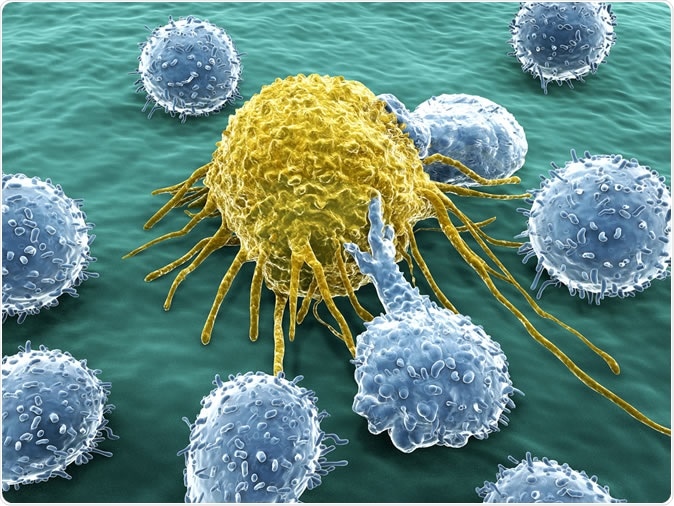Researchers from Britain and United States are working in collaboration to detect the earliest possible sign of cancer within the body and trace the alterations that lead to full blown cancer. This may help doctors detect cancer even before it is fully formed, the researchers hope. For this they are experimenting by starting on a group of cells and letting it become cancer or be “born” as cancer to see the changes at the cellular level on the first day of cancer formation.

Cancer cell and lymphocytes. Image Credit: Juan Gaertner / Shutterstock
The study comes from a team of researchers allied as International Alliance for Cancer Early Detection (ACED) which has scientists from Cancer Research UK, Universities of Cambridge, Manchester, University College London, and Stanford and Oregon in the US. According to the researchers, this research has tremendous potential in detecting cancer before it becomes cancer. It can help detection of cancer early and also look for signs that may in future turn into cancer. Dr David Crosby, head of early detection research at Cancer Research UK said in a statement, “The fundamental problem is that we never get to see a cancer being born in a human being. By the time it's found, it's already established.” The team warned that the actual results of their study and its utility in the clinical setting could be three decades away from now because it is like “looking for a needle in a haystack.”
For this study the team from Manchester are growing human breast tissue along with synthetic immune cells. They are studying the changes in the breast tissue that could later become cancer and also the changes in the immune system that could be seen with cancer in future. These experiments, explained Prof Rob Bristow was like a “living tissue bank outside patients.” The team explained that early breast cancer detection could mean 98 percent chance of survival which reduced to a mere 26 percent when the cancer is detected at a late and advanced stage. Only 44 percent breast cancers are detected at an early stage they added.
The team warns that not all cell changes seen in the early days ended up becoming cancers. This meant that diagnosing the cancer on the basis of initial changes could not always prove to be correct. To make their testing methods more precise the team says that genetics as well as the environment also needs to be considered. These could predict the individual’s personal risk of cancer.
Dr Crosby said that this alliance between researchers across more than one institute would, “induce a sea-change in our health systems, shifting it from expensive fire fighting of late-stage disease, to being able to intervene at its earliest point and deliver rapid, cost-effective treatment.”
At present screening tests are useful in early detection of several cancers such as bowel, breast, cervix etc. There are several cancers that however are not detected early using screening tests, and these usually have a high mortality rate. These include pancreas, ovary, prostate, lungs etc. Prof Mark Emberton, from UCL said that advent of MRI has been a revolution in detection and screening replacing biopsies and invasive tests. He said, “Imaging only sees the aggressive cells, it overlooks the stuff you don't want to find and addresses over-diagnosis.” He added that alternate tests are necessary for early detection of these cancers. Advanced imaging tests include hyper-polarised MRI scans, use of laser etc., he said. Prof Emberton added that these imaging tests could be the next big thing in cancer detection and screening.
Prof Rebecca Fitzgerald, at the University of Cambridge, is also working on an advanced endoscope that could detect early signs of cancers in the colon and the oesophagus. These early signs could include pre-cancerous lesions she explained. Prof Fitzgerald said that many studies could help move the science from “bench to the bedside”.
Michelle Mitchell, Cancer Research UK's chief executive, in a statement said, “Now is the time to be ambitious. We have the potential to completely change the future of cancer treatment, turning it into a manageable and beatable disease. Let us tackle this problem together and beat cancer.”
The project is also receiving an initial funding of £55million. Cancer Research UK is helping the International Alliance for Cancer Early Detection with £40m over the next five decades and Canary Center at Stanford University and the OHSU Knight Cancer Institute in Oregon is providing funds to the tune of $20m to the project. According to Prime Minister Boris Johnson, “Our brilliant scientists will be able to work together to develop detection technologies and implement them in our health service, so we can find cancer earlier and ultimately save people's lives. This is the transatlantic partnership at its very best.”